On the 22nd death anniversary of Scrabble creator Alfred Mosher Butts, we take a look at some famous board games that became the favourite pastime at many households over the years...
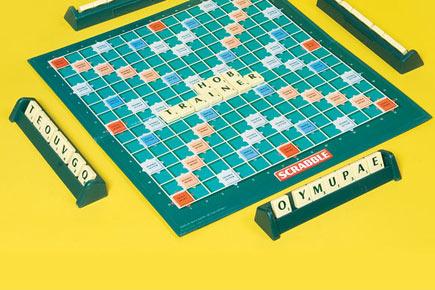
Scrabble
Scrabble: It is a board game, where two to four players score points by placing tiles, each bearing a single letter, onto a gameboard which is divided into a 15×15 grid of squares. The tiles must form words which, in crossword fashion, flow left to right in rows or downwards in columns and be defined in a standard dictionary.
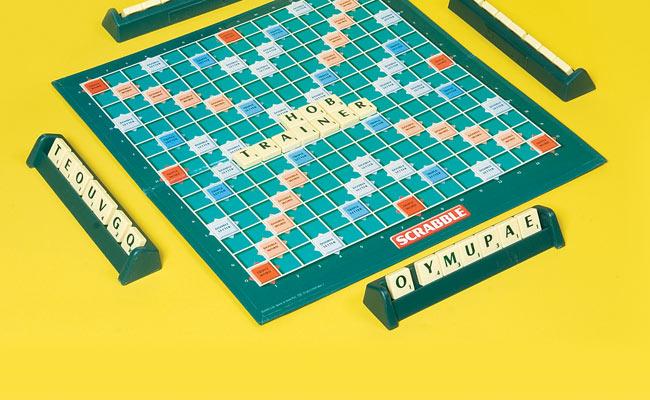
A scrabble board
Scrabble was invented in 1931, by Alfred Mosher Butts, an architect at Poughkeepsie in New York State, USA.” Unemployed at the time, Butts was keen on creating a combination of three pastimes that were popular — board games, crosswords and number games. To understand letter distribution, Butts studied the front page of The New York Times and calculated each alphabet’s frequency.
Alfred Mosher Butts originally called his invention, the 'Lexiko', but later changed it to 'Cris Cross Words'. Entrepreneur and game lover James Brunot renamed it 'Scrabble' in 1948 after the Dutch word 'Schrabben', which meant to scrape or scratch after buying the rights from Butts. By 1952, the game had gained considerable popularity since that time with over one hundred and fifty million sets being sold worldwide till now.
Pachisi: This cross and circle board game, which originated in ancient India where it is believed to be created perhaps as early as 500 AD, is called the Royal Game of India. This is because royalty used servants of the royal household adorned in colored costumes as game pieces on large outdoor boards. Such a court is preserved at the Fatehpur Sikri, where Emperor Akbar is said to have played the game in this fashion.
ADVERTISEMENT
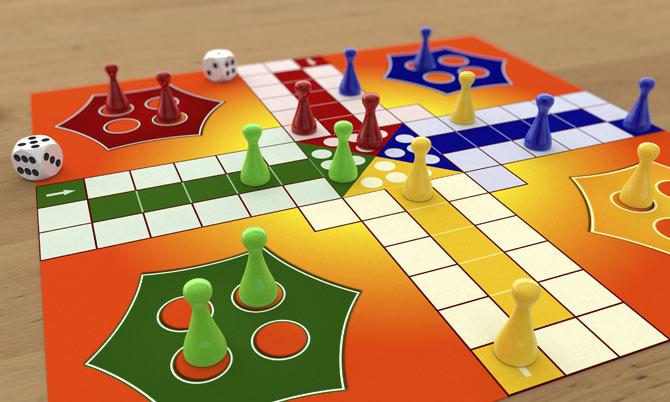
The British version of Pachisi known as Ludo
Pachisi is played on a board shaped like a symmetrical cross. A player's pieces move around the board based upon a throw of six or seven cowrie (sea snail) shells, with the number of shells resting with aperture upwards indicating the number of spaces to move. Four players usually play in two teams. One team has yellow and black pieces, the other team has red and green. The team which moves all its pieces to the finish first, wins the game. The name of the game derives from the Hindi word pachis, meaning twenty-five, the largest score that can be thrown with the cowrie shells
A western counterpart by the name of Parcheesi was invented by American toy and game manufacturers, the Parker Brothers. Other variants such as Ludo in Britain, the Korean board game Yunnori, Parchís, which is played in Spain and Norther Morocco also exist.
Snakes and Ladders: The board game, which also originated from ancient India is played between two or more players on a gameboard having numbered, gridded squares. A number of "ladders" and "snakes" are pictured on the board, each connecting two specific board squares. The object of the game is to navigate one's game piece, according to die rolls, from the start (bottom square) to the finish (top square), helped or hindered by ladders and snakes respectively. The game has roots in morality lessons, where a player's progression up the board represented a life journey complicated by virtues (ladders) and vices (snakes).

A variation of the game called Chutes and Ladders, with the snakes being replaced by chutes was popularized in the United States in 1943. It employs the same rules as the original. The game is also known as Saanp aur Seedhi, Saanp Seedhi and Mokshapat in Hindi.
The Game of Life: Also known as 'Life', this American board game created in 1860, simulates a person's travels through his or her life, from college to retirement, with jobs, marriage, and possible children along the way. Two to six players can participate in one game. Variations of the game accommodate eight to ten players.
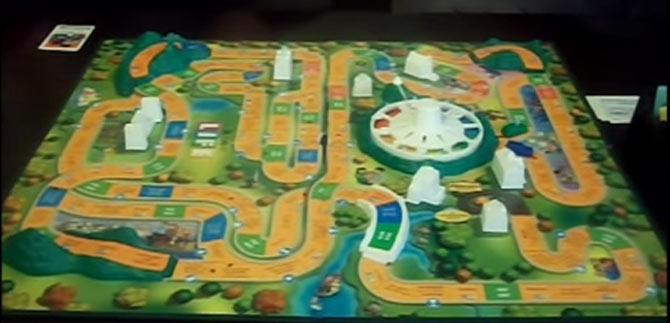
Pic/YouTube
A modern version, created by toy and game designer, Reuben Klamer was published 100 years after the original in 1960. It is now part of the permanent collection of the Smithsonian's National Museum of American History and later spawned a book, The Game of Life: How to Succeed in Real Life No Matter Where You Land. Life is considered as America's first popular parlor game.
Monopoly: This board game originated in the United States around 1903 as a way to demonstrate the evils of land ownership. It is named after the economic concept of monopoly—the domination of a market by a single entity. Players move around the gameboard buying or trading properties, developing their properties with houses and hotels, and collecting rent from their opponents, with the goal being to drive them all into bankruptcy leaving one monopolist in control of the entire economy.

A monopoly board. Pic/YouTube
The Monopoly gameboard consists of 40 spaces containing 28 properties (22 colored streets, four railway stations and two utilities), three Chance spaces, three Community Chest spaces, a Luxury Tax space, an Income Tax space, and the four corner squares: GO, (In) Jail/Just Visiting, Free Parking, and Go to Jail.
Monopoly's makers held an online vote in order to determine which cities would make it into an updated version of the Here and Now edition of the game. The game has underwent several changes over the years.
Mouse Trap: The game, which was invented in 1963 consists of 2 to 4 players who at first cooperate to build an extremely complicated mechanical mouse trap. After its construction, they turn against each other, attempting to trap opponents' mouse-shaped game pieces.
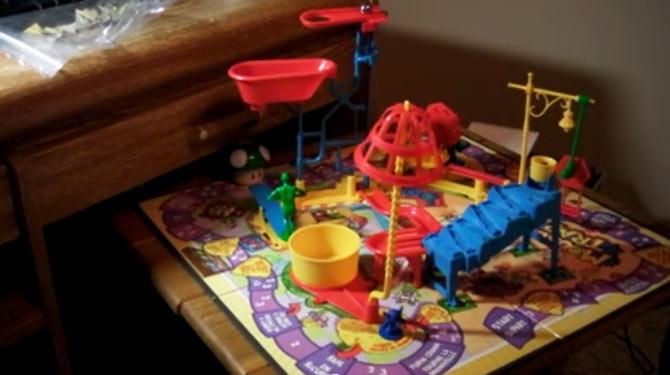
Pic/YouTube
Although the basic premise of the game has been consistent, the turn-based gameplay has changed somewhat over the years. The original version allowed the players almost no decision-making. In the 1970s, the board game surrounding the Mouse Trap was redesigned, adding the cheese pieces and allowing the player to maneuver opponents onto the trap space.
Pictionary: This guessing word game released in 1985 has players in teams of 4 our more trying to identify specific words from their teammates' drawings.
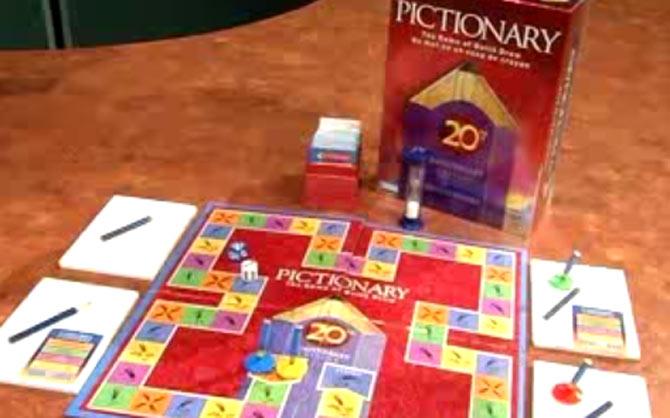
Pic/YouTube
Each team moves a piece on a game board formed by a sequence of squares, each containing a letter or shape identifying the type of picture to be drawn on it. The objective is to be the first team to reach the last space on the board. To achieve this a player must guess the word or phrase being drawn by their partner, or if the player lands on an "all play" square, one player from each team attempts to illustrate the same concept simultaneously, with the two teams racing to guess first. A one-minute timer, usually a sand timer, is used to compel players to rapidly complete their drawing and guessing.
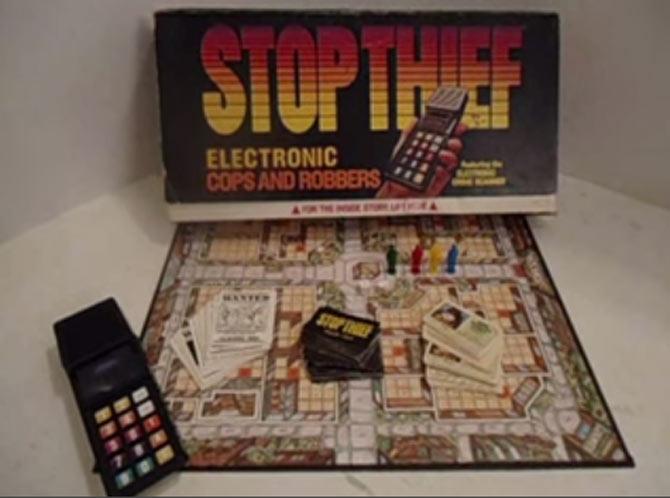
Pic/YouTube
Stop Thief: This electronic board game released in 1979 is played on a board with two six sided dice, plastic detective figures to represent positions on the board, and a Crime Scanner, a handheld calculator-like electronic and sound effects device. Players play as detectives tracking an invisible thief.
 Subscribe today by clicking the link and stay updated with the latest news!" Click here!
Subscribe today by clicking the link and stay updated with the latest news!" Click here!







